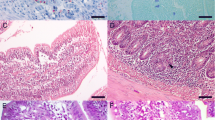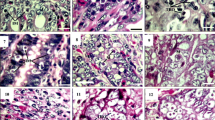Abstract
Flagellates from the caeca of a diseased hen and a diseased goose were transmitted to 35 specific pathogen-free (SPF) chickens. The flagellates of chicken origin were identified asChilomastix gallinarum, Tritrichomonas eberthi, andTetratrichomonas gallinarum. T. eberthi was not detected in the material of goose origin. Morphologic studies did not reveal any differences betweenChilomastix andTetratrichomonas specimens from chicken or goose origin. The species from the goose were identified asC. gallinarum andT. galliarum (Syn.T. anseris Hegner, 1929). Both trichomonad species produced pseudocysts that developed in the faeces of chickens within 3 h after excretion. Only 17% of the trichomonads excreted had reached the pseudocyst stage. All three flagellate species are infective to chickens when inoculated per rectum or per os or when consumed with chlorinated tap water. The prepatency period was always <24 h. SPF chickens between 2 and 30 days of age were equally susceptible. The infections persisted at a high level of intensity throughout the observation periods, i.e. up to 7 months. Of 35 inoculated SPF chickens, 2 developed disease (emaciation, ruffled feathers, diarrhoea, dilatation of the caeca). The three flagellate species were cultivated in Diamond's medium for 110 days. Cryopreserved and cultivated flagellates retained their infectivity to chickens.
Similar content being viewed by others
References
Bondarenko OI (1964) Pathogenicity and specificity of trichomonads in chickens and ducks. Veterinariya (Moscow) 41:64–65
Chauve CM, Reynaud MC (1989) Etude d'unTetratrichomonas, parasite des caecums du “canard mulard”. Bull Soc F Parasitol 7:3–11
Davis ED, Schwartz LD, Jordan HE (1964) A case report:Chilomastix sp. infection in pen-raised quail. Avian Dis 8:465–470
Hegner R (1929) The infection of parasite-free chicks with intestinal protozoa from birds and other animals. Am J Hyg 10:33–62
Honigberg BM (1947) The characteristics of the flagellateMonocercomonas verrens sp. n. fromTapirus malayanus. Univ Calif Berkeley Publ Zool 53:227–236
Honigberg BM (1961) Comparative pathogenicity ofTrichomonas vaginalis andTrichomonas gallinae for mice: I. Gross pathology, quantitative evaluation of virulence and some factors affecting pathogenicity. J Parasitol 47:545–569
Honigberg BM (1963) Evolutionary and systematic relationships in the flagellate order Trichomonadida Kirby. J Protozool 10:20–63
Honigberg BM (1978) Trichomonads of verterinary importance. In: Kreier JP (ed) Parasitic protozoa, vol 2. Academic Press, New York San Francisco London, pp 200–273
Huber L, Maran B (1970) Durch Trichomonaden verursachte Todesfälle bei Aras und Tschajas. In: Erkrankungen der Zootiere. Proceedings, 12th International Symposium, Budapest, pp 301–302.
Kösters J, Grimm F (1987) Die mögliche Bedeutung vonChilomastix gallinarum als Krankheitserreger bei Wassergeflügel. In: Erkrankungen der Zootiere. Proceedings, 29th International Symposium, Cardiff, pp 57–60
Kösters J, Cubillos A, Ulloa J (1976) Chilomastix sp. en gansos domesticos de Chile. Bol Chile Parasitol 31:84–85
Kösters J, Cubillos A, Zülch S (1978) Cultivor deChilomastix sp. de gansos: inhibicion in vitro e in vivo. Bol Chile Parasitol 33:69–72
Kösters J, Cubillos A, Schütze HR (1979) Experimentelle Untersuchungen zur Kontrolle derChilomastix-Infektion bei Hausgeflügel mit Metronidazol. Berl Münch Tierärztl Wochenschr 92:266–268
Kotlan A (1923) Zur Kenntnis der Darmflagellaten aus der Hausente und anderen Wasservögeln. Zentralbl Bakteriol Parasitenkd Infektionskr Abt Orig Reihe A 90:24–28
Kulda J, Nohynkova E (1978) Flagellates of the human intestine and of intestines of other species. In: Kreier JP (ed) Parasitic protozoa, vol 2. Academic Press, New York San Francisco London, pp 2–118
Kulda J, Suchankova E, Svoboda S (1974) Studies on pathogenicity ofTetratrichomonas gallinarum in mice and turkey poults. Acta Vet (Brno) 43:53–64
Martin CH, Robertson M (1911) Further observations on the caecal parasites of fowls, with some reference to the rectal fauna of other vertebrates. Part 1. Q J Microsc Sci 57:53–81
McDowell S Jr. (1953) A morphological and taxonomic study of the caecal protozoa of the common fowl,Gallus gallus. J Morphol 92:337–399
Nie D (1950) Morphology and taxonomy of the intestinal protozoa of the guinea-pig,Cavia porcella. J Morphol 86:381–494
Reynaud MC, Chauve CM (1990) Etude d'urTetratrichomonas parasite des caecums du “canard mulard”. Bull Soc F Parasitol 8:3–8
Richardson FL (1934) Studies on experimental epidemiology of intestinal protozoan infections in birds. Am J Hyg 20:373–403
Richardson FL (1939) Cecectomy of chicks and its effect upon their growth and infectability with intestinal flagellates. Am J Hyg 30:69–71
Stachan R, Nicol C, Kunstyr I (1984) Heterogeneity ofTritrichomonas muris pseudocysts. Protistologica 20:157–163
Tanabe M (1926) Morphological studies onTrichomonas. J Parasitol 12:120–130
Travis BV (1932)Trichomonas phasiani, a new flagellate from the ring-necked pheasantPhasianus torquatus Gmelin. J Parasitol 18:285–287
Ziesmer C (1951) Eine Verbesserung der Silberimprägnierung nach Bodian. Z Mikrosk 60:58–59
Author information
Authors and Affiliations
Additional information
Dedicated to Prof. Dr. J. Eckert on the occasion of his 60th birthday
Rights and permissions
About this article
Cite this article
Friedhoff, K.T., Kuhnigk, C. & Müller, I. Experimental infections in chickens withChilomastix gallinarum, Tetratrichomonas gallinarum, andTritrichomonas eberthi . Parasitol Res 77, 329–334 (1991). https://doi.org/10.1007/BF00930910
Accepted:
Issue Date:
DOI: https://doi.org/10.1007/BF00930910




